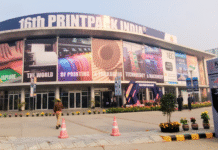
In his welcome address to the Wan-Ifra Printers Summit this morning, Shanth Kumar of The Printers Mysore group spoke about a vibrant newspaper industry ravaged by the Covid-19 pandemic and its ensuing lockdowns. He said, “Apart from the advertising and circulation hits that Indian newspapers have taken in the pandemic, our journalists have taken a beating from the cost-cutting of the publishers as well as from Covid-19 itself.”
The 18 November morning hybrid session with about 80 or 90 participants physically present and another 30 tuning in online, was a panel discussion on CAPEX and OPEX moderated by RD Bhatnagar of the Dainik Bhaskar group. Bhatnagar who is always optimistic said right at the beginning that a roomful of engineers can do anything – in a way prefacing the discussion which centered on the need for cooperation and collaboration within the industry.
Sustaining old CAPEX and a new look at OPEX
The first panelist, BS Shesh of the HT Media group suggested that Capex be put into two baskets – that of looking at the “Capex already sunk in, which may require the reconfiguration of our plants.” The implication was that one of the major Opex savings effected in the past two years of reducing pagination may also require the reconfiguration of press lines. On Opex, he added that “We are already the champions of controlling waste but now we need to look at the expenditures outside of mere production and at possible inputs such as solar power. We need to look at the redundancy of assets that the industry has always valued and to collaborate to share capacity.” He also implied that the industry needs to move away from stockpiling every spare that may be discontinued to a network that spreads some of the risks of mission-critical machines in a kind of shared reliability mission.

RP Lakshmivenkataram of The Hindu group said that reducing operational expenditure unfortunately also implies some Capex on automation technologies. While saying that a great deal of Opex has already been achieved by page-level reduction, on the subject of sharing production facilities by multiple newspapers, he asked, “Can the reduced pagination and number of copies [that are currently being produced] allow us to optimize the production timings in plants that take on the production of multiple dailies?”
Speaking on the behalf of suppliers, TechNova’s Amit Khurana also pointed to the large printing plant assets created by newspaper publishers that are only utilized for four hours each night. He confessed that his company and other suppliers too have experienced a bumpy ride in demand over the past two years. Khurana suggested that all remedies need to be tried from better long-term forecasting of demand to the 3D printing of spare parts including those of CtP devices. “Up to 30 to 40% of spares could be produced using 3D printers,” he said.
Collaboration of newspapers
The discussion was taken up by several engineers in the audience. Snehashish Roy of the Bennet-Coleman TOI group suggested that in the present situation both the publishers and the suppliers are in a weakened condition. He suggested that a collaborative program be undertaken to locally upgrade and refurbish the imported presses that are now over 20 years old in some cases and we need to look at sustaining these machines “to a good healthy life.” Implying that the up-gradation by the manufacturers is either not feasible or too expensive, he said that his company had already successfully refurbished two of its double-width presses using high-quality modern drives sourced within the country. Roy said, “I would like publishers to share their resources for refurbishing old machines with new automation and drives.”
PV Narayanan of the Dinamalar group endorsed the discussion in favor of engineering collaboration that was taking place implying that the Indian newspaper industry has access to many skilled and responsible resources, “We have a lot of experience between us. Some wonderful engineers can take responsibility and we should be looking for five-year warranties on technology and upgrades.”
On the sustainability of older machines, Shesh said, “While it’s not possible to upgrade and pump in a few crore at one time, we try to climb the slope gradually by upgrading something every year. Obsolescence of our big machines is a real concern, but in all types of upgradations we need to keep the OEMs with us on the same page.” He added that apart from the collaboration between publishers, “There is no alternative to engineering development within the organizations.”
OPEX can benefit from 40 GSM newsprint standardization
Both Bhatnagar and Lakshmivenkataman agreed that printing on 40 gsm newsprint is one of the options for reducing operational costs that can lead to a savings of 6%. Narayan interjected some of the precautions needed for changing over to the thinner substrate and others pointed to the need for Indian newsprint mills to also produce 40 gsm newsprint that meets some of the necessary parameters.
Essentially the discussion brought out the seriousness of the situation – where a needed and till recently relatively healthy newspaper industry’s proponents see that its condition is dire. That it sees its future in collaboration even while competing and that it is looking to its large pool of engineering skills and knowledge for sustaining its collective infrastructure. Bhatnagar ended the session by calling out to the room full of engineers. “Each one of you is responsible for turning around this industry. We will be able to help the industry,” he said. One only hopes the publishers are listening.















